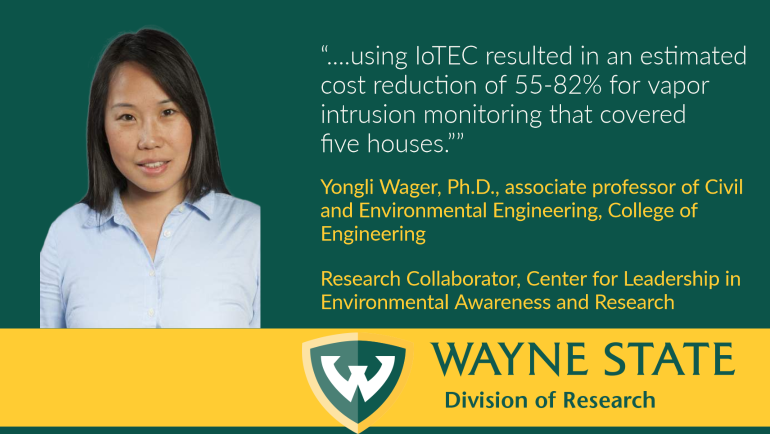Wayne State University researchers improve environmental monitoring applications

DETROIT – A research team from Wayne State University’s National Institutes of Health-funded Superfund Research Program, the Center for Leadership in Environmental Awareness and Research (CLEAR), recently published a paper that describes a new technique they developed that couples the Internet of Things sensor network with Edge Computing (IoTEC) to improve environmental monitoring. The paper, “IoT-based edge computing (IoTEC) for improved environmental monitoring,” was published recently in Sustainable Computing.
Internet of Things allows researchers to monitor environmental parameters onsite, gathering and transmitting data over the internet so it can be analyzed remotely. While this technology has improved onsite monitoring and data processing, it is limited by its high energy usage, internet bandwidth and data storage requirements.
To address this challenge, the research team led by Yongli Wager, Ph.D., associate professor of civil and environmental engineering in Wayne State’s College of Engineering, incorporated edge computing — a hybrid data model that uses edge servers and cloud computing to keep data analysis close to the source while still allowing data processing on the cloud when needed.
The researchers tested their sensor packages in two pilot applications to monitor vapor intrusion of pollution moving from air spaces in soil to indoor air and algae cultivation in wastewater.
“In our first pilot study on vapor intrusion monitoring, we found that IoTEC-based monitoring revealed a reduction in unnecessary data transmission and data latency, or how long it takes for data to be stored or retrieved,” said Wager. “In addition, using IoTEC resulted in an estimated cost reduction of 55-82% for vapor intrusion monitoring that covered five houses.”
In the second pilot study, the researchers used machine learning tools with IoTEC to monitor and predict system performance of wastewater-based algae cultivation. By implementing different machine learning algorithms at edge servers, they discovered data processing and analysis improved.
According to the authors, using IoTEC compared to more conventional sensor monitoring methods can have a significant impact on research studies. The research revealed that IoTEC can lower the energy and bandwidth needs for data transmission, shorten response times, and reduce costs, overall alleviating current challenges to real-time environmental monitoring.
Other study members of the CLEAR Wayne State research team included Javad Roostaei, Ph.D., Department of Civil and Environmental Engineering; Department of Computer Science; Timothy Dittrich, Ph.D., Department of Civil and Environmental Engineering; Carol Miller, Ph.D., Department of Civil and Environmental Engineering; and Kishore Gopalakrishnan, Ph.D., Department of Biological Sciences. Weisong Shi, Ph.D. of the University of Delaware is also a collaborator on the project.
This research was supported by the National Institute of Environmental Health Sciences of the National Institutes of Health, grant number P42 ES030991.
###
About Wayne State University Division of Research
Wayne State University is one of the nation’s pre-eminent public research universities in an urban setting. Through its multidisciplinary approach to research and education, and its ongoing collaboration with government, industry and other institutions, the university seeks to enhance economic growth and improve the quality of life in the city of Detroit, state of Michigan and throughout the world. For more information about research at Wayne State University, visit research.wayne.edu.
About Wayne State University College of Engineering
Founded in 1933, the Wayne State University College of Engineering improves quality of life through engineering and computer science education, research innovation and entrepreneurship. The 3,300-member student body benefits from a robust academic system with more than 50 degree and certificate programs, as well as a diverse and inclusive environment nestled in the college's vibrant urban setting of Midtown Detroit, down the street from a host of industry partners. A network of 30,000 alumni are changing the world in 48 countries and all 50 states. For more information, visit engineering.wayne.edu.
About the Center for Leadership in Environmental Awareness and Research
The Center for Leadership in Environmental Awareness and Research is a National Institute of Environmental Sciences of the National Institutes of Health center dedicated to understanding and mitigating adverse birth outcomes and serious developmental health problems that have been associated with exposure to volatile organic chemicals, a class of pollutants frequently present below the ground surface, especially in post-industrial cities like Detroit. To learn more about CLEAR, visit clear.wayne.edu.
Contact info
Julie O'Connor
Director, Research Communications
Phone: 313-577-8845
Email: julie.oconnor@wayne.edu